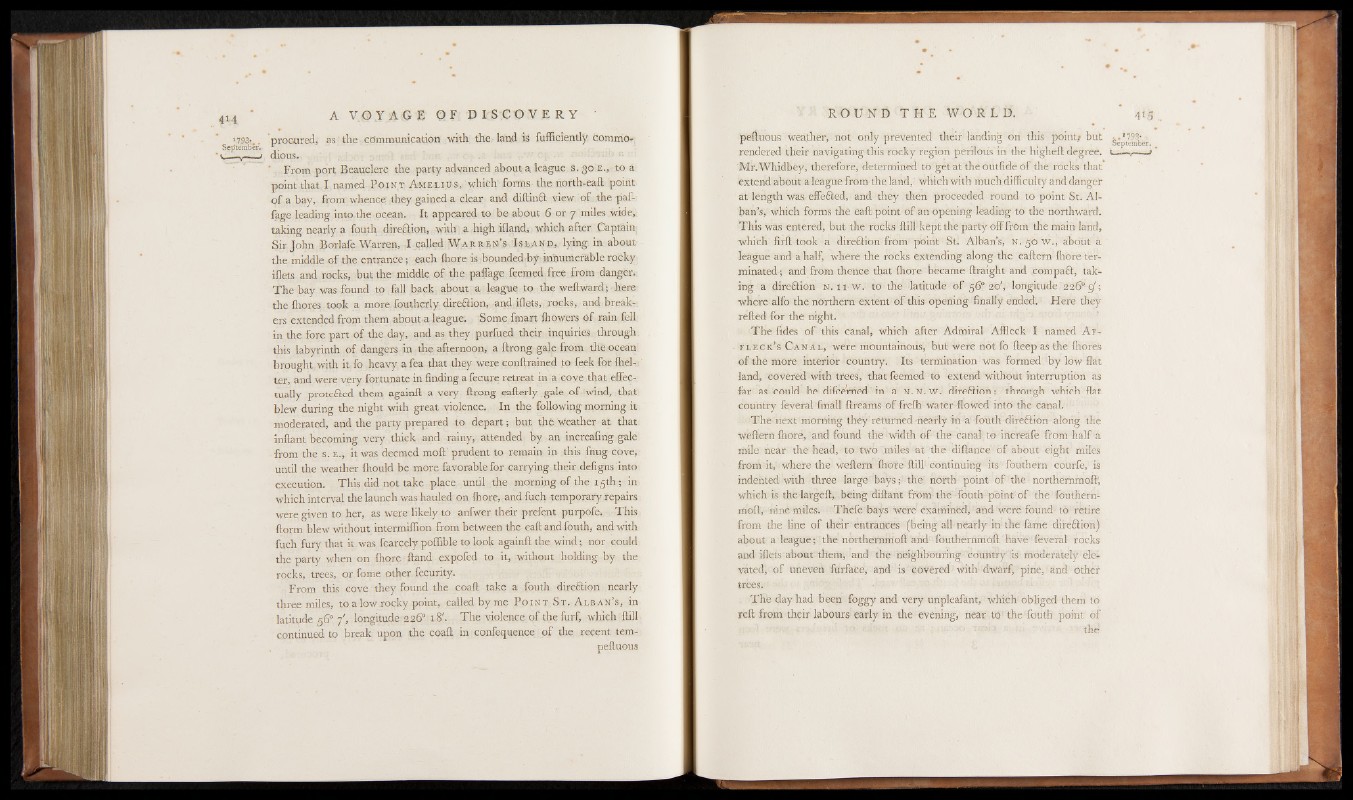
i n
414
1793!. .
September.
A V O Y A G E O F D I S C O V E R Y
procured, as the communication with the land is fufficientty Commodious..
' From port Beauclerc the party advanced about a league s. 30 e., to a
point that I named P o in t A m e l iOs, •which' forms the north-eaft point
o f a bay, from whence' they gained a clear and diitinct view of the paf-
fage leading into the ocean. It appeared to be about 6 or 7 miles wide,
taking nearly, a fouth direction, with a high iflatid, which after Captain
Sir John Borlafe Warren, I called W a r r e n ’s I slan d , lying in about
the middle of the entrance; each fliore is bounded-by-innumerable rocky
iflets and rocks, but the middle of the paffage feemed free from danger.
The bay was found to . fall back, about a league to the weliward; here
the fhores took a more, foutherly dire&ion, apd; iflets,,rocks, and break-:
ers extended from them about .a league. Some fmart fhowers of rain fell
in the fore part of the day, and as they purfued their inquiries, through
this labyrinth of dangers in the afternoon, a ftrong gale from the.ocean
brought with it fo heavy a fea that they were conftrained to feek for fhel-
ter, and were very fortunate in finding a fecure retreat in a cove that effectually
protected them again!! a very ftrong eafterly. gale of wind, that
blew during the night with great violence. In the following morning it
moderated, and the party prepared to depart; but the weather at that
inftant becoming very thick and rainy, attended by an increafing gale
from the s.E., it was deemed mod’ prudent to remain in this fnug cove,
until the weather fhould be more favorable for carrying their defigns into
execution. This did not take place until the morning of the 15th; in
which interval the launch was hauled on fhore, and fuch temporary repairs
were given to her, as were likely to anfwer their prefent purpofe. This
ftorm blew without intermiflion from between the eaft and fouth, and with
fuch fury that it was fcarcely poflible to look againft the wind; nor could
the party when on fliore Hand expofed to it, without holding by the
rocks, trees, or fome other fecurity.
From this cove they found the coaft take a fouth direftion nearly
three miles, to a low rocky point, called by me P o in t S t . A lban ’s, in
latitude 56° 7', longitude 226° 18'. The violence of the furf, which ftill
continued to break- upon the coaft in confequence of the recent tempeftuous
R O U N D T H E W O R L D . 415
peftuous weather, not only prevented their landing on this point? but g-pt^ cr
rendered their navigating this rocky region perilous in the higheft degree. t_ — -1
Mr.Whidbey, therefore, determined to get at the outfide of the rocks that’
extend about a league from the land, which with much difficulty and danger
at length was effefted, and they then proceeded round to point St. Alban’s,
which forms the eaft point of an opening leading to the northward.
This was entered, but the rocks ftill kept the party off from the main land,
which firft took a direction frorw ptiint St. Alban’s, N. JO w., about a
league and a half, where the rocks extending along the eaftern fhore terminated;
and from thence that fhore became ftraight and compaft, taking
a direction n . 11 w . to the latitude of 56? 20',; longitude7226° 9';
where alfo the northern extent o f this opening finally ended.1 Here they
refted for the night,
The fides of this canal, which after Admiral Affleck I named Aff
l e c k ’s C a n A l , were mountainous, but were not fo fteep as the fhores
o f the more interior-country. Its termination was formed by low flat
land, covered with trees, that feemed to extend without interruption as
far as-could be difeerried in a n.'n. w . direftion; through which flat
country feveral fmall dreams of frefh water flowed into the canal.
The next morning they*returned nearly in a fouth direction along the
weftern fhore, and found the width of the canal to increafe from half a
mile near the head, to two 'miles at the diftanee’ of about eight miles
from it, where the weftern fhore ftill continuing its- fouthern courfe, is
indented with three large; bays; thenorth point of the northernmoft;
which is thelargeft, being diftant from the fouth point of the fouthem-
moft, nine miles, Thefe bays Were examined, and were found to retire
from the line of their- entrances (being all nearly in the fame1 direflion)
about a league;’the northemmoft and fouthernmoft have feveral rocks
and iflets about them, and the neighbouring country is moderately elevated,
of uneven furfaCe, and is covered with- dwarf, \ pine, and other
trees. I
The day had been foggy and very unpleafant, which obliged them to
reft from their labours early in the evening, near to the fouth point of
the